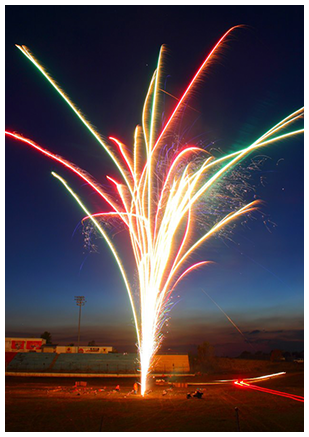Consumer Product Safety Commission Proposed Rule Change That Could Ban Many Aerial Consumer Fireworks

Sign The Save Our Fireworks Petition
Summary
The Consumer Product Safety Commission (CPSC) is considering a new rule that would dramatically change the testing procedures for aerial consumer fireworks, which would likely lead to the ban of many devices that have been legally imported, and sold in the United States for decades.
Current Fireworks Regulations
Consumer aerial devices are limited to two grains (130 mg) of pyrotechnic content if they contain fine metals in their burst charge and are solely intended to produce an audible effect (e.g., a bang or a pop) instead of a visual effect (e.g., the break of a shell). Currently, the CPSC staff evaluates whether devices are intended to produce an audible effect by listening to the sound level of a device (e.g., ear test).
Draft Rule
The CPSC's draft rule would ban all aerial devices with more than two grains of pyrotechnic content if a powdered metal is detected in the burst charge. The CPSC's rationale for changing the rule is that the existence of powdered metals is a better indicator of the explosive power of a device than the sound level of its report.
Several Problems with the Draft Rule
The potential effect of the draft rule on what devices are permissible is dramatic. The CPSC randomly tested fireworks samples collected from the years 2014 to 2016. Using the criteria in the current rule, the CPSC determined that only 17 percent of the tested devices were intended to produce an audible effect and were subject to the two-grain limitation. However, using the criteria in the proposed rule, the CPSC determined that 84 percent of devices would be subject to the two-grain limitation. That is to say that the draft rule would increase the amount of aerial devices subject to the two-grain limitation substantially. In other words, the draft rule could increase the amount of aerial devices subject to the two-grain limitation by 394 percent.
This means that the CPSC's draft rule would likely serve as a de facto ban on the most popular consumer fireworks devices like reloadable/single shot shells, aerial multi shot devices, and stick rockets.
|

|
Current Testing Methods are Fatally Flawed
Under the proposed rule, the CPSC would conduct laboratory testing of devices to determine whether they have powdered metal in their burst charges. The type of test that would be used is called an X-Ray Fluorescence ("XRF") test. The XRF test is fatally flawed in two ways.
1. The XRF testing cannot tell the difference between the powdered metals and metallic compounds. This is a major problem because simply being a metallic compound (which is found in fireworks components and construction materials like clay and adhesives) has absolutely nothing to do with the explosive power of the burst charge.
2. Contamination of burst charges is unavoidable due to the way that they are manufactured, stored, and shipped. In consumer fireworks devices, it is common for color effect stars and burst charges to be comingled. This allows powdered metals in frangible stars to become detached and contaminate the burst charge of an aerial device. The powdered metal contaminates do not have a material effect of the explosive power of a burst charge, and most often have no effect at all. In sum, the XRF test that the CPSC would use to enforce its proposed rule is not appropriate. Its use would ban many devices for reasons that have little to do with the explosive force of the devices and any potential concerns with the increased risk of injury to end users.